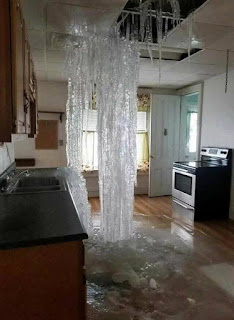 |
| Don’t Let this happen to you! |
Protecting your home or business from water damage is essential to maintaining a healthy, affordable living environment. In addition to presenting health risks, water damage is expensive to treat. For instance, the cost to address water damage from a burst pipe averages $15,000 USD. While most types of water damage are covered by insurance providers, many carriers have strict requirements for clients with a history of water damage. Fortunately, there are some simple steps that you can take as a property owner to avoid water damage to your home or business. Below are ten tips to help you avoid water damage to your home or business.
1) Make preventive maintenance a top priority.
The path to preventing water damage begins with your commitment to monitoring your water lines, hoses, and shut-off valves. The first step in this process is to make sure you know where all of your water shut-off valves are located. This includes your main shut-off valve and all indoor and outdoor valves for sinks, appliances, faucets, and water heaters.
2) Always turn off the water before leaving town.
Whether you are leaving for a business trip or a family vacation, you should always turn off your water before you leave your home or office. This is an essential
step for winterizing your plumbing to help safeguard against leaks and breaks that can result from freezing temperatures.
3) Purchase high-quality water lines.
Purchasing high-quality water lines for your refrigerator and washer can help minimize the risk of leaks and subsequent damage. In general,
copper and braided stainless steel tubing are superior to plastic, which can easily be ruptured. Regardless of the lines that you purchase, make sure you inspect them periodically to ensure that they are intact.
4) Drain your water heater on a regular basis.
Maintaining your water heater requires a consistent approach. The frequency with which you should drain your water heater depends on
how hard your water is. In general, a water heater’s tank should be flushed at least once per year. It is also important to make sure the temperature is properly set to prevent burns.
5) Know your sprinkler system.
If you install a sprinkler system, make sure you request a map of the line locations. This information will be needed if repairs are warranted or if you are planning a landscaping project that requires digging.
6) Invest in high-quality washer hook-up hoses.
As in the case of water lines, quality is important when purchasing hook-up hoses for your washer. Avoid hoses made of plastic or rubber, as they can leak or break when exposed to high pressure. A more dependable choice is hoses made of
braided stainless steel as they are more resistant to pressure.
7) Monitor your gutters and downspouts.
Periodically monitoring your gutters and downspouts is vital to protecting your home or business from water damage. Check all of your gutters and downspouts during the next rainstorm to ensure that water is flowing freely and away from your home or business.
8) Disconnect outdoor drain pipes and garden hoses before cold weather strikes.
This measure helps safeguard against water from freezing in the pipes that are on the inside of your home or church. It also prevents cracks from forming in your hoses. Sometimes hose shut-off valves are located inside a home or business, so make sure to look both indoors and outdoors for hose valves.
9) Make sure that your furnace A/C evaporation drain is free of clogs.
The line that extends from your furnace to a nearby drain is your furnace A/C evaporation drain. It is typically located close to your furnace and is often attached to a laundry tub or sink. Check this drain periodically to make sure that it is clog-free.
10) Ensure that dirt or rock is flush with the foundation of your home or business.
Failure to follow this tip can create a gap to form around the foundation of your home, causing pressure and potentially leading to cracks in your foundation. The dirt or rock should be elevated and gradually slope downward from your home or office building in order to direct water away from the foundation of your home.
By following the ten tips above, you can help prevent costly water damage and dangerous health risks. For more tips on preventing water damage, contact an
industry expert.
Financial Products and Insurance are provided through partner carriers. See disclosures and product materials for specific features and benefits. An agency relationship is not created by viewing or reading this blog. Examples of protection are not all-inclusive and policyholders should refer to their policies for full coverage details. ©Smith-Kenyon Insurance Resources, LLC 2018


